A Comprehensive Analysis of Managing Cross-Cultural Teams in Business
VerifiedAdded on 2022/11/07
|10
|2369
|401
Essay
AI Summary
This essay examines the critical aspects of managing cross-cultural teams in a globalized world. It focuses on Geert Hofstede's cultural dimensions model, a framework used to understand and compare cultural differences in the workplace. The essay explores each of Hofstede's six dimensions—power distance, individualism/collectivism, uncertainty avoidance, masculinity/femininity, time orientation, and indulgence—and how they impact team dynamics and management strategies. It provides examples of how these dimensions manifest in different cultures and offers insights into how managers can navigate cultural differences to foster effective teamwork and mitigate potential conflicts. The essay concludes by emphasizing the importance of using various cultural frameworks and tools to address cultural conflicts effectively, particularly in the face of increasing market competition and the need for adaptability.
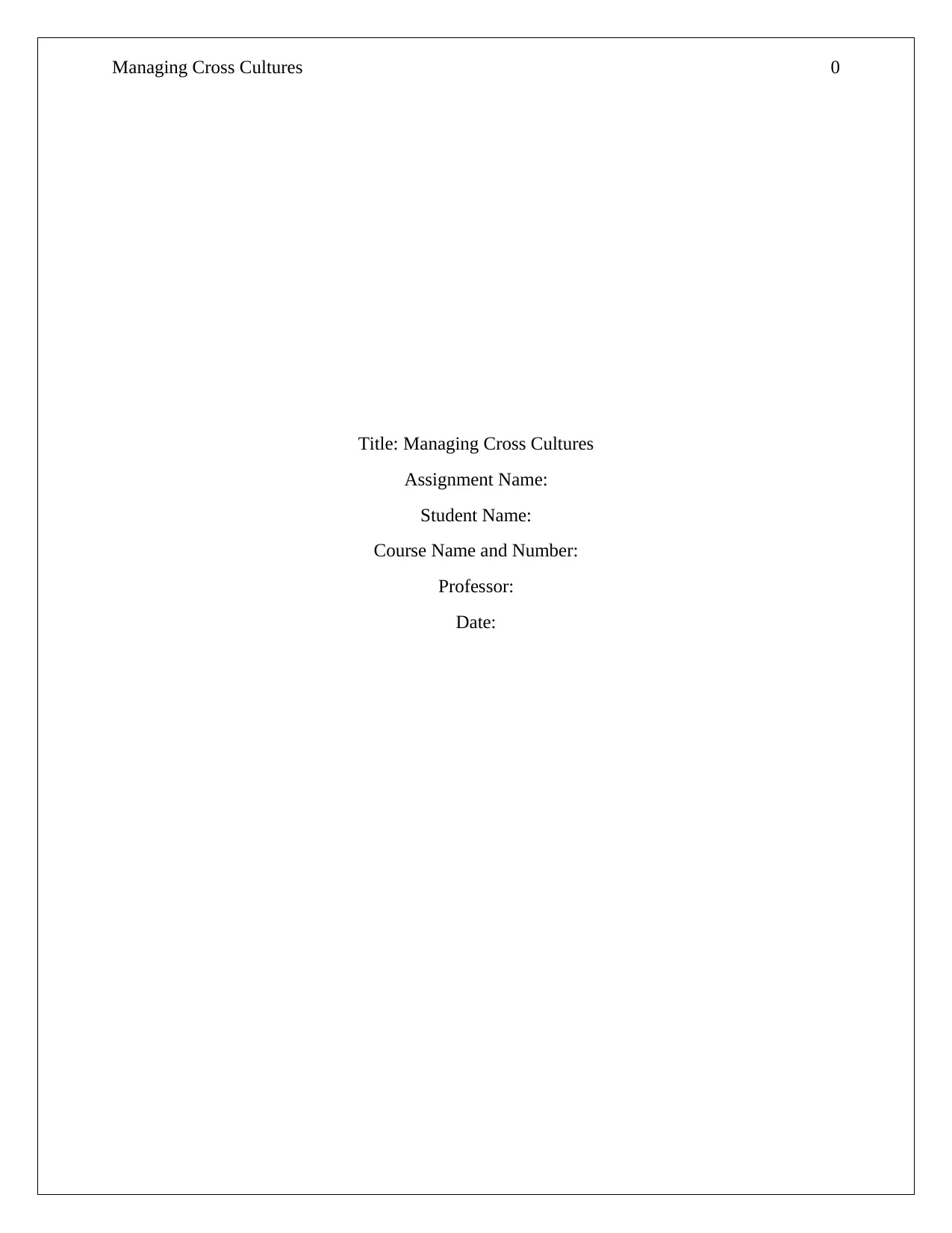
Managing Cross Cultures 0
Title: Managing Cross Cultures
Assignment Name:
Student Name:
Course Name and Number:
Professor:
Date:
Title: Managing Cross Cultures
Assignment Name:
Student Name:
Course Name and Number:
Professor:
Date:
Paraphrase This Document
Need a fresh take? Get an instant paraphrase of this document with our AI Paraphraser
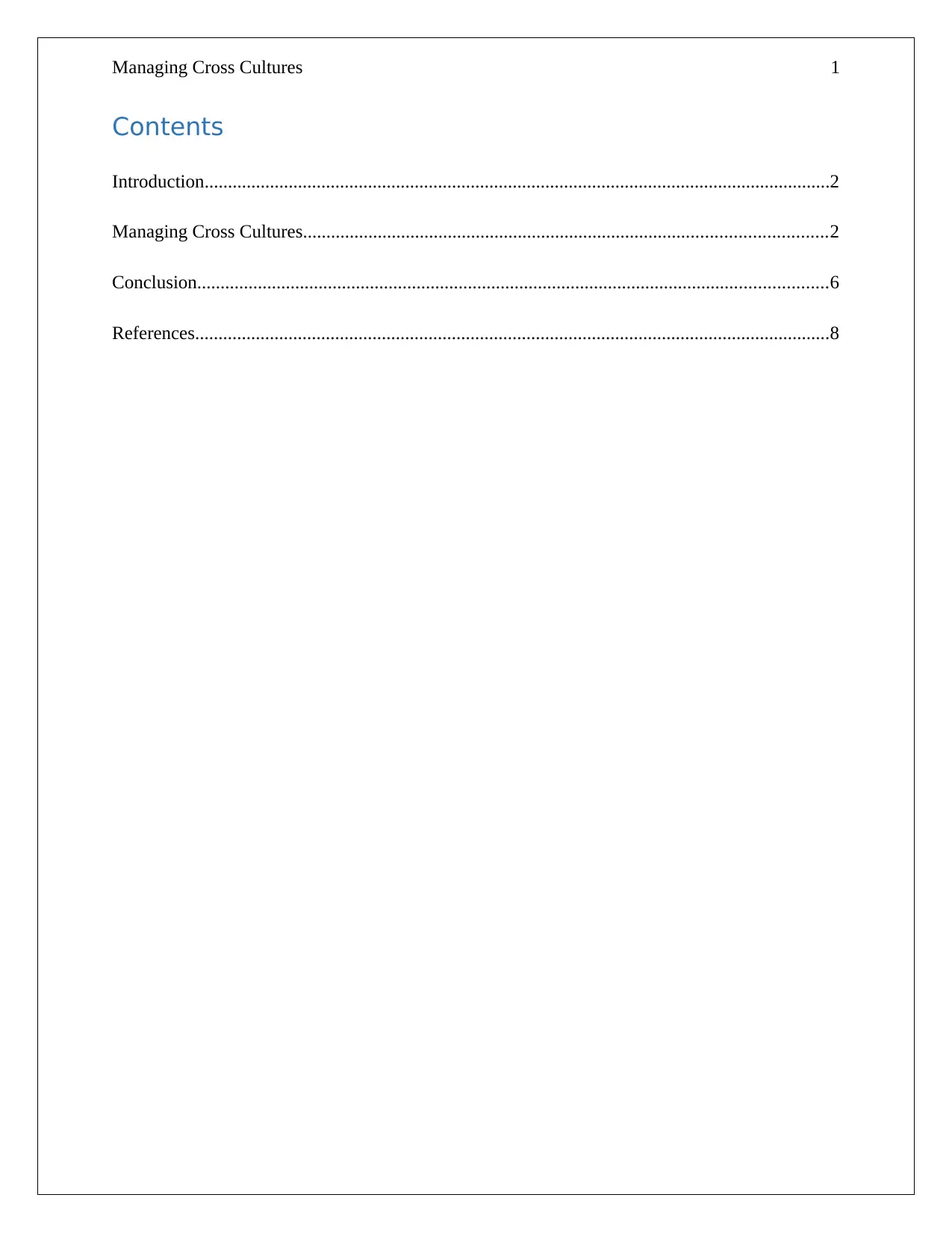
Managing Cross Cultures 1
Contents
Introduction......................................................................................................................................2
Managing Cross Cultures................................................................................................................2
Conclusion.......................................................................................................................................6
References........................................................................................................................................8
Contents
Introduction......................................................................................................................................2
Managing Cross Cultures................................................................................................................2
Conclusion.......................................................................................................................................6
References........................................................................................................................................8
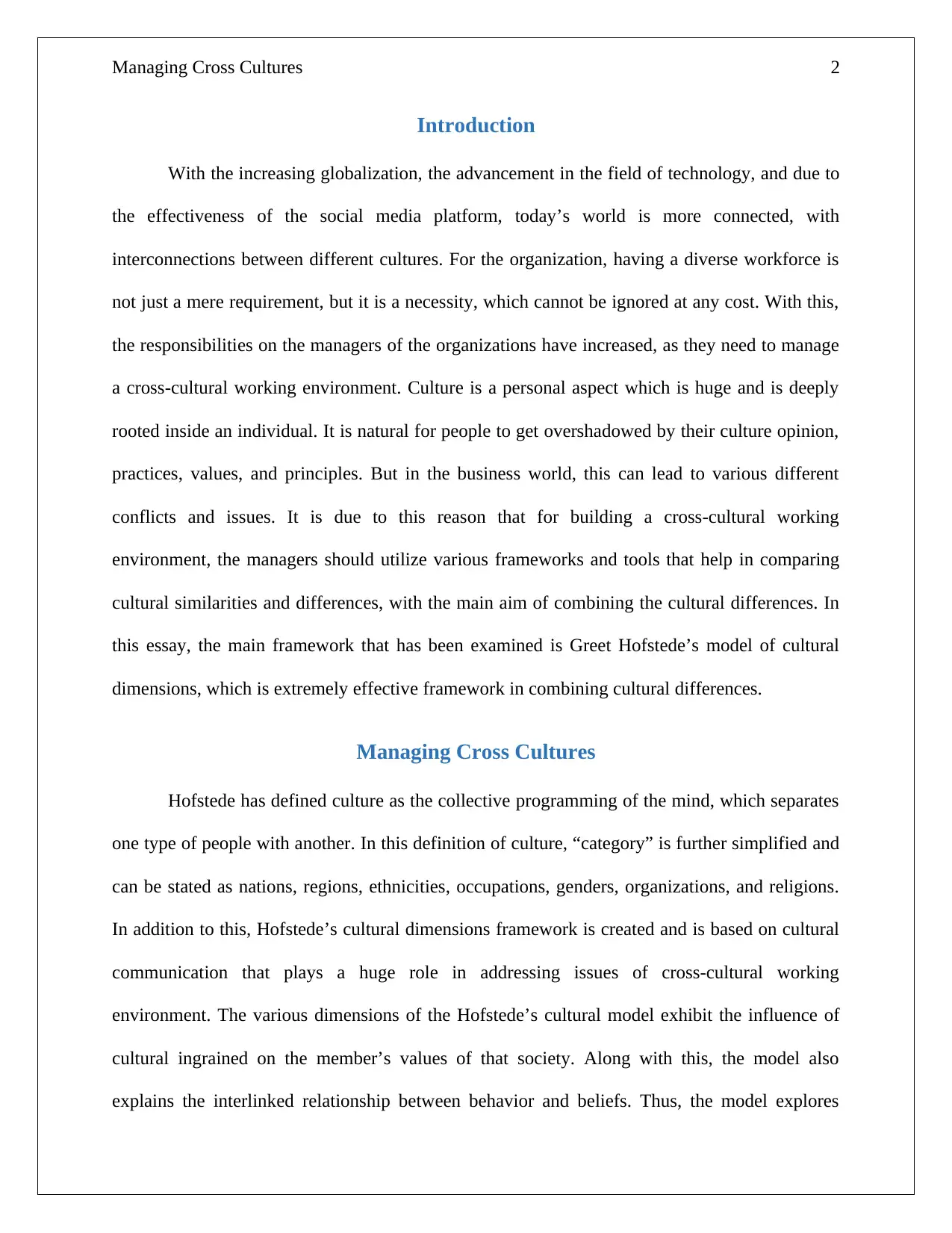
Managing Cross Cultures 2
Introduction
With the increasing globalization, the advancement in the field of technology, and due to
the effectiveness of the social media platform, today’s world is more connected, with
interconnections between different cultures. For the organization, having a diverse workforce is
not just a mere requirement, but it is a necessity, which cannot be ignored at any cost. With this,
the responsibilities on the managers of the organizations have increased, as they need to manage
a cross-cultural working environment. Culture is a personal aspect which is huge and is deeply
rooted inside an individual. It is natural for people to get overshadowed by their culture opinion,
practices, values, and principles. But in the business world, this can lead to various different
conflicts and issues. It is due to this reason that for building a cross-cultural working
environment, the managers should utilize various frameworks and tools that help in comparing
cultural similarities and differences, with the main aim of combining the cultural differences. In
this essay, the main framework that has been examined is Greet Hofstede’s model of cultural
dimensions, which is extremely effective framework in combining cultural differences.
Managing Cross Cultures
Hofstede has defined culture as the collective programming of the mind, which separates
one type of people with another. In this definition of culture, “category” is further simplified and
can be stated as nations, regions, ethnicities, occupations, genders, organizations, and religions.
In addition to this, Hofstede’s cultural dimensions framework is created and is based on cultural
communication that plays a huge role in addressing issues of cross-cultural working
environment. The various dimensions of the Hofstede’s cultural model exhibit the influence of
cultural ingrained on the member’s values of that society. Along with this, the model also
explains the interlinked relationship between behavior and beliefs. Thus, the model explores
Introduction
With the increasing globalization, the advancement in the field of technology, and due to
the effectiveness of the social media platform, today’s world is more connected, with
interconnections between different cultures. For the organization, having a diverse workforce is
not just a mere requirement, but it is a necessity, which cannot be ignored at any cost. With this,
the responsibilities on the managers of the organizations have increased, as they need to manage
a cross-cultural working environment. Culture is a personal aspect which is huge and is deeply
rooted inside an individual. It is natural for people to get overshadowed by their culture opinion,
practices, values, and principles. But in the business world, this can lead to various different
conflicts and issues. It is due to this reason that for building a cross-cultural working
environment, the managers should utilize various frameworks and tools that help in comparing
cultural similarities and differences, with the main aim of combining the cultural differences. In
this essay, the main framework that has been examined is Greet Hofstede’s model of cultural
dimensions, which is extremely effective framework in combining cultural differences.
Managing Cross Cultures
Hofstede has defined culture as the collective programming of the mind, which separates
one type of people with another. In this definition of culture, “category” is further simplified and
can be stated as nations, regions, ethnicities, occupations, genders, organizations, and religions.
In addition to this, Hofstede’s cultural dimensions framework is created and is based on cultural
communication that plays a huge role in addressing issues of cross-cultural working
environment. The various dimensions of the Hofstede’s cultural model exhibit the influence of
cultural ingrained on the member’s values of that society. Along with this, the model also
explains the interlinked relationship between behavior and beliefs. Thus, the model explores
⊘ This is a preview!⊘
Do you want full access?
Subscribe today to unlock all pages.

Trusted by 1+ million students worldwide
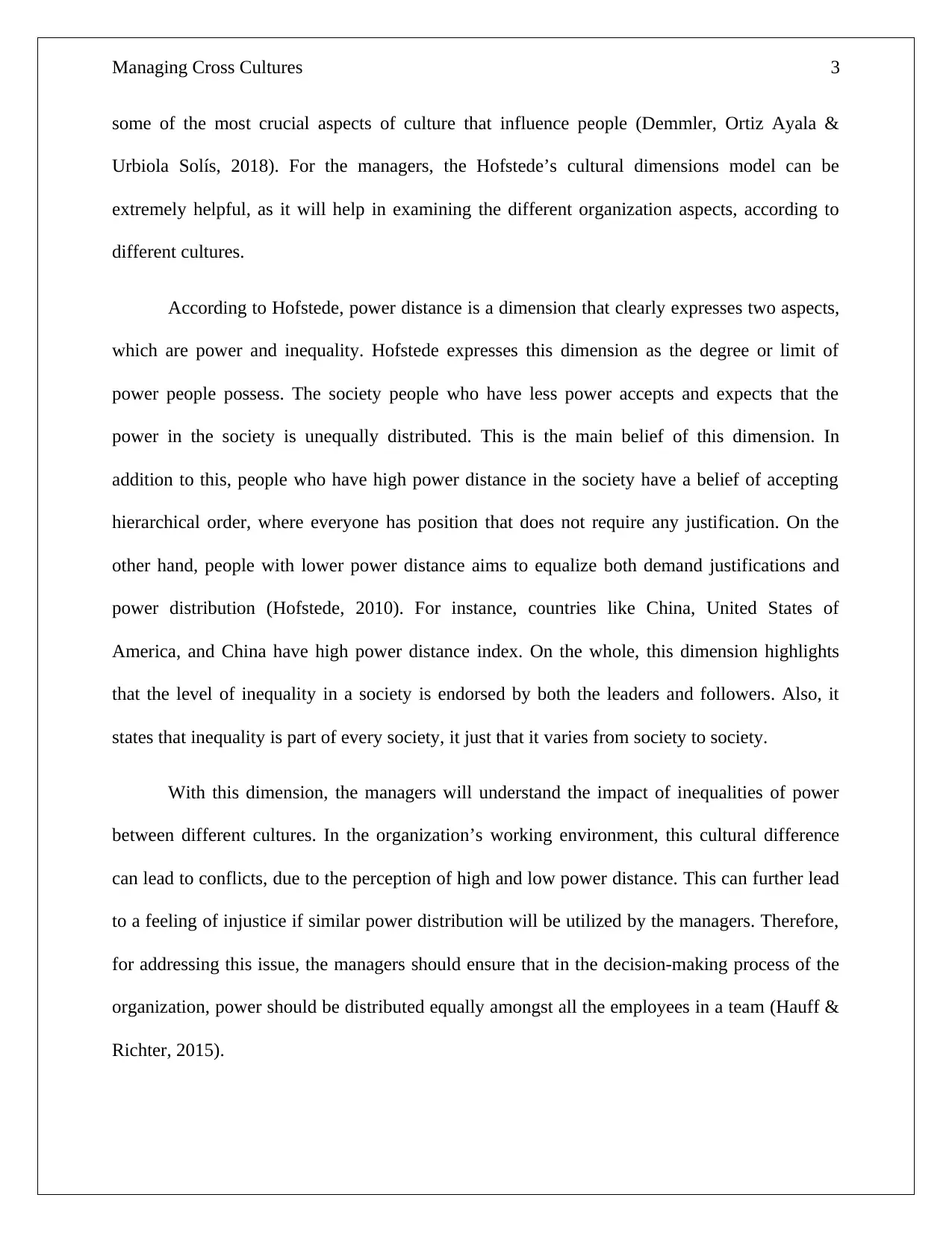
Managing Cross Cultures 3
some of the most crucial aspects of culture that influence people (Demmler, Ortiz Ayala &
Urbiola Solís, 2018). For the managers, the Hofstede’s cultural dimensions model can be
extremely helpful, as it will help in examining the different organization aspects, according to
different cultures.
According to Hofstede, power distance is a dimension that clearly expresses two aspects,
which are power and inequality. Hofstede expresses this dimension as the degree or limit of
power people possess. The society people who have less power accepts and expects that the
power in the society is unequally distributed. This is the main belief of this dimension. In
addition to this, people who have high power distance in the society have a belief of accepting
hierarchical order, where everyone has position that does not require any justification. On the
other hand, people with lower power distance aims to equalize both demand justifications and
power distribution (Hofstede, 2010). For instance, countries like China, United States of
America, and China have high power distance index. On the whole, this dimension highlights
that the level of inequality in a society is endorsed by both the leaders and followers. Also, it
states that inequality is part of every society, it just that it varies from society to society.
With this dimension, the managers will understand the impact of inequalities of power
between different cultures. In the organization’s working environment, this cultural difference
can lead to conflicts, due to the perception of high and low power distance. This can further lead
to a feeling of injustice if similar power distribution will be utilized by the managers. Therefore,
for addressing this issue, the managers should ensure that in the decision-making process of the
organization, power should be distributed equally amongst all the employees in a team (Hauff &
Richter, 2015).
some of the most crucial aspects of culture that influence people (Demmler, Ortiz Ayala &
Urbiola Solís, 2018). For the managers, the Hofstede’s cultural dimensions model can be
extremely helpful, as it will help in examining the different organization aspects, according to
different cultures.
According to Hofstede, power distance is a dimension that clearly expresses two aspects,
which are power and inequality. Hofstede expresses this dimension as the degree or limit of
power people possess. The society people who have less power accepts and expects that the
power in the society is unequally distributed. This is the main belief of this dimension. In
addition to this, people who have high power distance in the society have a belief of accepting
hierarchical order, where everyone has position that does not require any justification. On the
other hand, people with lower power distance aims to equalize both demand justifications and
power distribution (Hofstede, 2010). For instance, countries like China, United States of
America, and China have high power distance index. On the whole, this dimension highlights
that the level of inequality in a society is endorsed by both the leaders and followers. Also, it
states that inequality is part of every society, it just that it varies from society to society.
With this dimension, the managers will understand the impact of inequalities of power
between different cultures. In the organization’s working environment, this cultural difference
can lead to conflicts, due to the perception of high and low power distance. This can further lead
to a feeling of injustice if similar power distribution will be utilized by the managers. Therefore,
for addressing this issue, the managers should ensure that in the decision-making process of the
organization, power should be distributed equally amongst all the employees in a team (Hauff &
Richter, 2015).
Paraphrase This Document
Need a fresh take? Get an instant paraphrase of this document with our AI Paraphraser
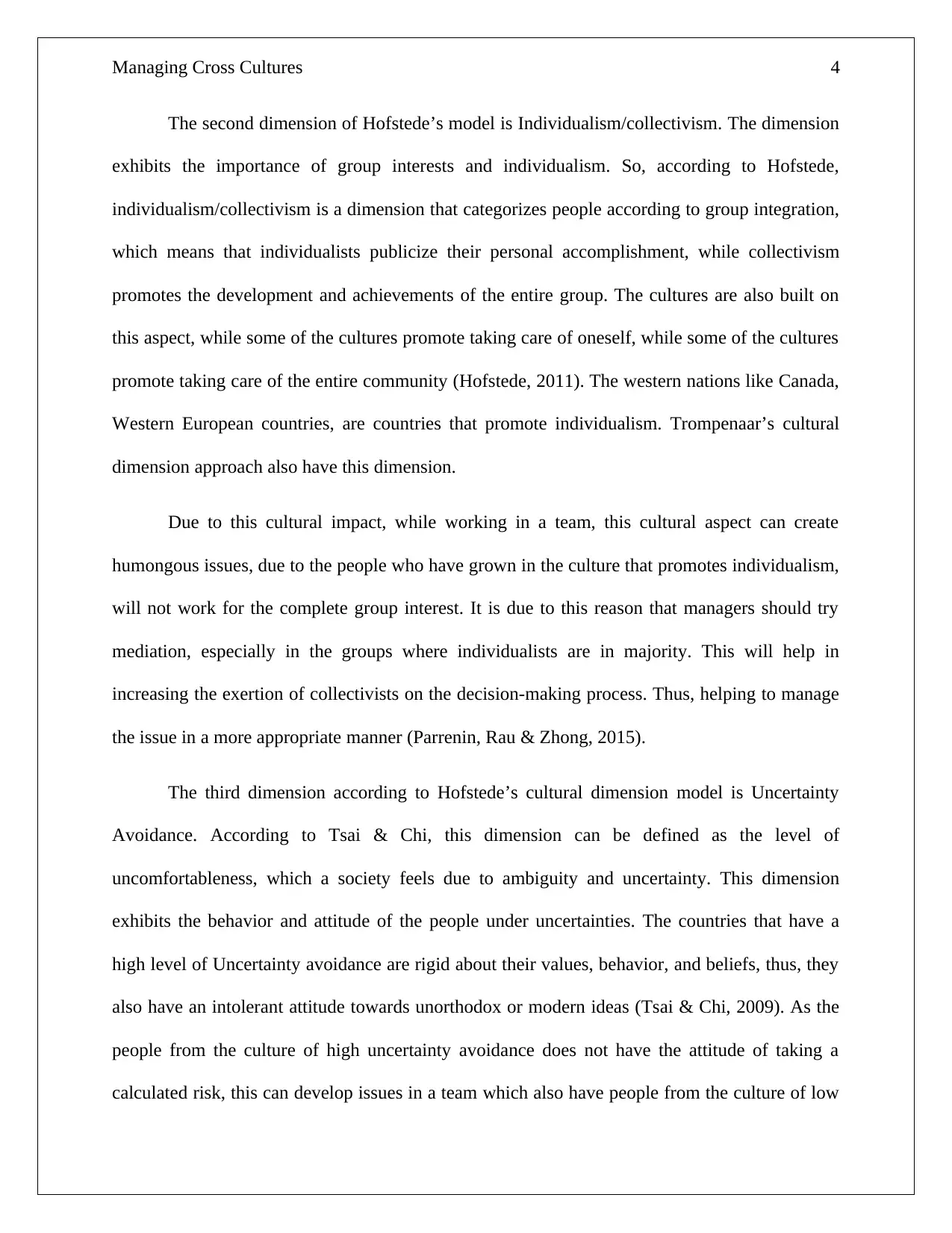
Managing Cross Cultures 4
The second dimension of Hofstede’s model is Individualism/collectivism. The dimension
exhibits the importance of group interests and individualism. So, according to Hofstede,
individualism/collectivism is a dimension that categorizes people according to group integration,
which means that individualists publicize their personal accomplishment, while collectivism
promotes the development and achievements of the entire group. The cultures are also built on
this aspect, while some of the cultures promote taking care of oneself, while some of the cultures
promote taking care of the entire community (Hofstede, 2011). The western nations like Canada,
Western European countries, are countries that promote individualism. Trompenaar’s cultural
dimension approach also have this dimension.
Due to this cultural impact, while working in a team, this cultural aspect can create
humongous issues, due to the people who have grown in the culture that promotes individualism,
will not work for the complete group interest. It is due to this reason that managers should try
mediation, especially in the groups where individualists are in majority. This will help in
increasing the exertion of collectivists on the decision-making process. Thus, helping to manage
the issue in a more appropriate manner (Parrenin, Rau & Zhong, 2015).
The third dimension according to Hofstede’s cultural dimension model is Uncertainty
Avoidance. According to Tsai & Chi, this dimension can be defined as the level of
uncomfortableness, which a society feels due to ambiguity and uncertainty. This dimension
exhibits the behavior and attitude of the people under uncertainties. The countries that have a
high level of Uncertainty avoidance are rigid about their values, behavior, and beliefs, thus, they
also have an intolerant attitude towards unorthodox or modern ideas (Tsai & Chi, 2009). As the
people from the culture of high uncertainty avoidance does not have the attitude of taking a
calculated risk, this can develop issues in a team which also have people from the culture of low
The second dimension of Hofstede’s model is Individualism/collectivism. The dimension
exhibits the importance of group interests and individualism. So, according to Hofstede,
individualism/collectivism is a dimension that categorizes people according to group integration,
which means that individualists publicize their personal accomplishment, while collectivism
promotes the development and achievements of the entire group. The cultures are also built on
this aspect, while some of the cultures promote taking care of oneself, while some of the cultures
promote taking care of the entire community (Hofstede, 2011). The western nations like Canada,
Western European countries, are countries that promote individualism. Trompenaar’s cultural
dimension approach also have this dimension.
Due to this cultural impact, while working in a team, this cultural aspect can create
humongous issues, due to the people who have grown in the culture that promotes individualism,
will not work for the complete group interest. It is due to this reason that managers should try
mediation, especially in the groups where individualists are in majority. This will help in
increasing the exertion of collectivists on the decision-making process. Thus, helping to manage
the issue in a more appropriate manner (Parrenin, Rau & Zhong, 2015).
The third dimension according to Hofstede’s cultural dimension model is Uncertainty
Avoidance. According to Tsai & Chi, this dimension can be defined as the level of
uncomfortableness, which a society feels due to ambiguity and uncertainty. This dimension
exhibits the behavior and attitude of the people under uncertainties. The countries that have a
high level of Uncertainty avoidance are rigid about their values, behavior, and beliefs, thus, they
also have an intolerant attitude towards unorthodox or modern ideas (Tsai & Chi, 2009). As the
people from the culture of high uncertainty avoidance does not have the attitude of taking a
calculated risk, this can develop issues in a team which also have people from the culture of low
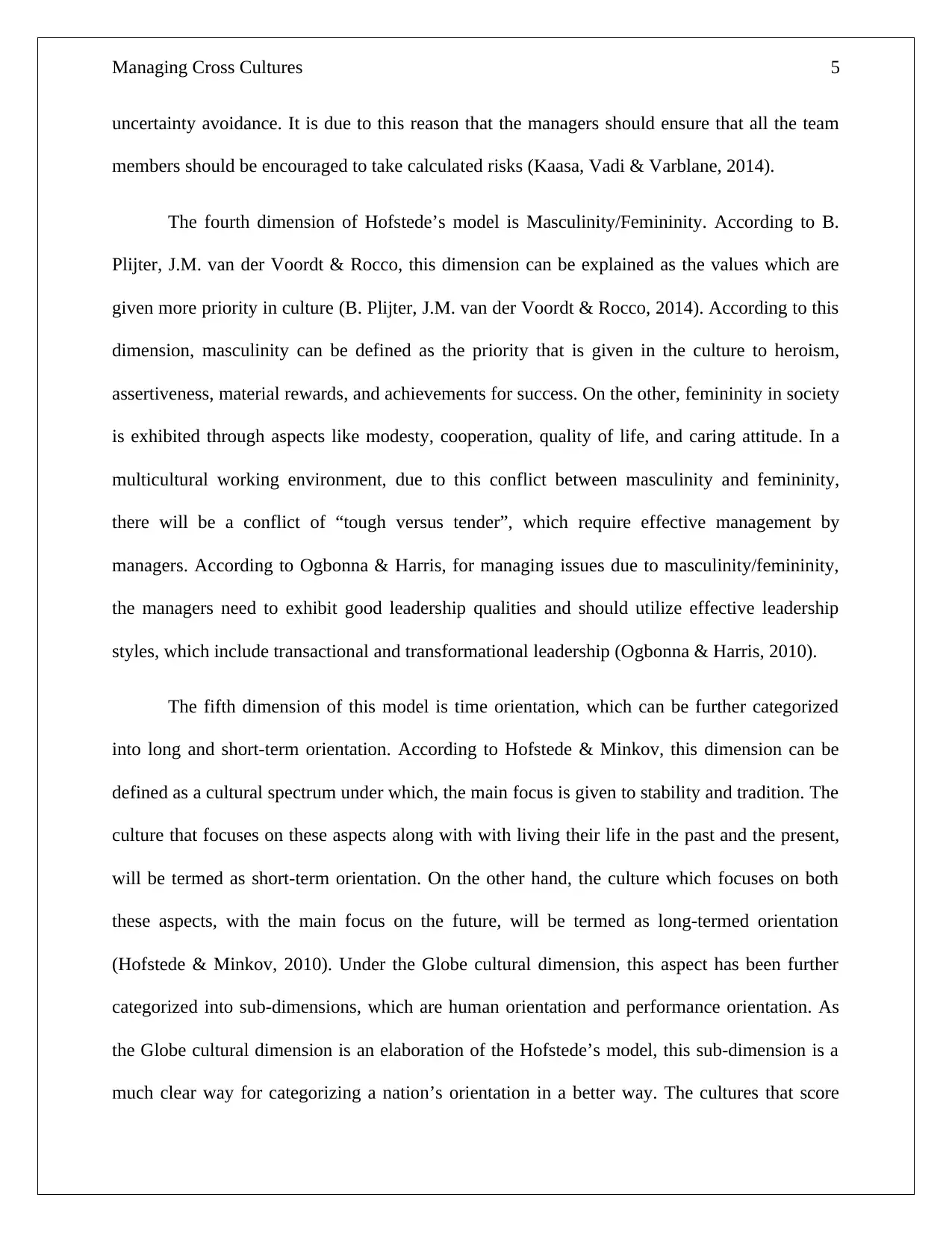
Managing Cross Cultures 5
uncertainty avoidance. It is due to this reason that the managers should ensure that all the team
members should be encouraged to take calculated risks (Kaasa, Vadi & Varblane, 2014).
The fourth dimension of Hofstede’s model is Masculinity/Femininity. According to B.
Plijter, J.M. van der Voordt & Rocco, this dimension can be explained as the values which are
given more priority in culture (B. Plijter, J.M. van der Voordt & Rocco, 2014). According to this
dimension, masculinity can be defined as the priority that is given in the culture to heroism,
assertiveness, material rewards, and achievements for success. On the other, femininity in society
is exhibited through aspects like modesty, cooperation, quality of life, and caring attitude. In a
multicultural working environment, due to this conflict between masculinity and femininity,
there will be a conflict of “tough versus tender”, which require effective management by
managers. According to Ogbonna & Harris, for managing issues due to masculinity/femininity,
the managers need to exhibit good leadership qualities and should utilize effective leadership
styles, which include transactional and transformational leadership (Ogbonna & Harris, 2010).
The fifth dimension of this model is time orientation, which can be further categorized
into long and short-term orientation. According to Hofstede & Minkov, this dimension can be
defined as a cultural spectrum under which, the main focus is given to stability and tradition. The
culture that focuses on these aspects along with with living their life in the past and the present,
will be termed as short-term orientation. On the other hand, the culture which focuses on both
these aspects, with the main focus on the future, will be termed as long-termed orientation
(Hofstede & Minkov, 2010). Under the Globe cultural dimension, this aspect has been further
categorized into sub-dimensions, which are human orientation and performance orientation. As
the Globe cultural dimension is an elaboration of the Hofstede’s model, this sub-dimension is a
much clear way for categorizing a nation’s orientation in a better way. The cultures that score
uncertainty avoidance. It is due to this reason that the managers should ensure that all the team
members should be encouraged to take calculated risks (Kaasa, Vadi & Varblane, 2014).
The fourth dimension of Hofstede’s model is Masculinity/Femininity. According to B.
Plijter, J.M. van der Voordt & Rocco, this dimension can be explained as the values which are
given more priority in culture (B. Plijter, J.M. van der Voordt & Rocco, 2014). According to this
dimension, masculinity can be defined as the priority that is given in the culture to heroism,
assertiveness, material rewards, and achievements for success. On the other, femininity in society
is exhibited through aspects like modesty, cooperation, quality of life, and caring attitude. In a
multicultural working environment, due to this conflict between masculinity and femininity,
there will be a conflict of “tough versus tender”, which require effective management by
managers. According to Ogbonna & Harris, for managing issues due to masculinity/femininity,
the managers need to exhibit good leadership qualities and should utilize effective leadership
styles, which include transactional and transformational leadership (Ogbonna & Harris, 2010).
The fifth dimension of this model is time orientation, which can be further categorized
into long and short-term orientation. According to Hofstede & Minkov, this dimension can be
defined as a cultural spectrum under which, the main focus is given to stability and tradition. The
culture that focuses on these aspects along with with living their life in the past and the present,
will be termed as short-term orientation. On the other hand, the culture which focuses on both
these aspects, with the main focus on the future, will be termed as long-termed orientation
(Hofstede & Minkov, 2010). Under the Globe cultural dimension, this aspect has been further
categorized into sub-dimensions, which are human orientation and performance orientation. As
the Globe cultural dimension is an elaboration of the Hofstede’s model, this sub-dimension is a
much clear way for categorizing a nation’s orientation in a better way. The cultures that score
⊘ This is a preview!⊘
Do you want full access?
Subscribe today to unlock all pages.

Trusted by 1+ million students worldwide
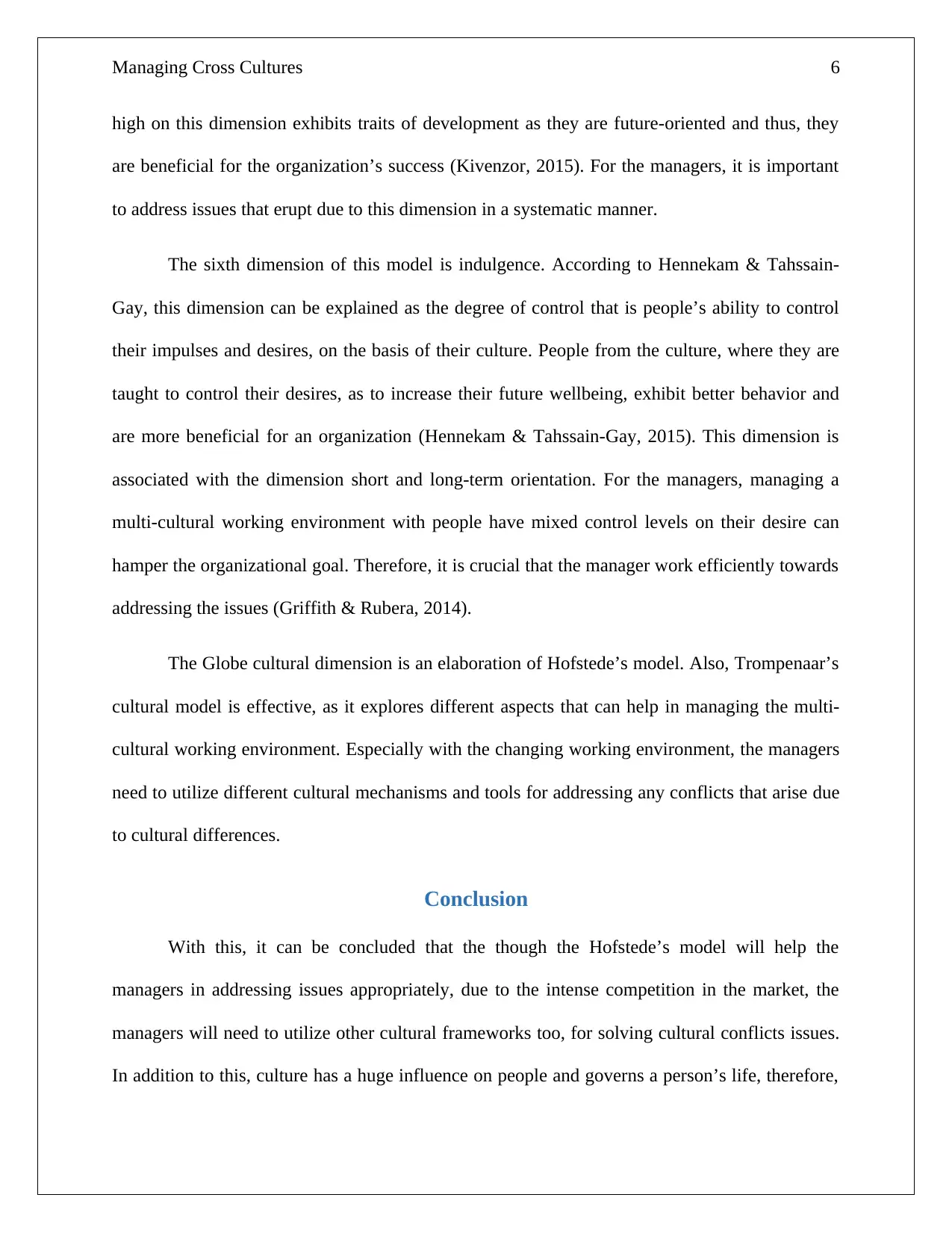
Managing Cross Cultures 6
high on this dimension exhibits traits of development as they are future-oriented and thus, they
are beneficial for the organization’s success (Kivenzor, 2015). For the managers, it is important
to address issues that erupt due to this dimension in a systematic manner.
The sixth dimension of this model is indulgence. According to Hennekam & Tahssain-
Gay, this dimension can be explained as the degree of control that is people’s ability to control
their impulses and desires, on the basis of their culture. People from the culture, where they are
taught to control their desires, as to increase their future wellbeing, exhibit better behavior and
are more beneficial for an organization (Hennekam & Tahssain-Gay, 2015). This dimension is
associated with the dimension short and long-term orientation. For the managers, managing a
multi-cultural working environment with people have mixed control levels on their desire can
hamper the organizational goal. Therefore, it is crucial that the manager work efficiently towards
addressing the issues (Griffith & Rubera, 2014).
The Globe cultural dimension is an elaboration of Hofstede’s model. Also, Trompenaar’s
cultural model is effective, as it explores different aspects that can help in managing the multi-
cultural working environment. Especially with the changing working environment, the managers
need to utilize different cultural mechanisms and tools for addressing any conflicts that arise due
to cultural differences.
Conclusion
With this, it can be concluded that the though the Hofstede’s model will help the
managers in addressing issues appropriately, due to the intense competition in the market, the
managers will need to utilize other cultural frameworks too, for solving cultural conflicts issues.
In addition to this, culture has a huge influence on people and governs a person’s life, therefore,
high on this dimension exhibits traits of development as they are future-oriented and thus, they
are beneficial for the organization’s success (Kivenzor, 2015). For the managers, it is important
to address issues that erupt due to this dimension in a systematic manner.
The sixth dimension of this model is indulgence. According to Hennekam & Tahssain-
Gay, this dimension can be explained as the degree of control that is people’s ability to control
their impulses and desires, on the basis of their culture. People from the culture, where they are
taught to control their desires, as to increase their future wellbeing, exhibit better behavior and
are more beneficial for an organization (Hennekam & Tahssain-Gay, 2015). This dimension is
associated with the dimension short and long-term orientation. For the managers, managing a
multi-cultural working environment with people have mixed control levels on their desire can
hamper the organizational goal. Therefore, it is crucial that the manager work efficiently towards
addressing the issues (Griffith & Rubera, 2014).
The Globe cultural dimension is an elaboration of Hofstede’s model. Also, Trompenaar’s
cultural model is effective, as it explores different aspects that can help in managing the multi-
cultural working environment. Especially with the changing working environment, the managers
need to utilize different cultural mechanisms and tools for addressing any conflicts that arise due
to cultural differences.
Conclusion
With this, it can be concluded that the though the Hofstede’s model will help the
managers in addressing issues appropriately, due to the intense competition in the market, the
managers will need to utilize other cultural frameworks too, for solving cultural conflicts issues.
In addition to this, culture has a huge influence on people and governs a person’s life, therefore,
Paraphrase This Document
Need a fresh take? Get an instant paraphrase of this document with our AI Paraphraser
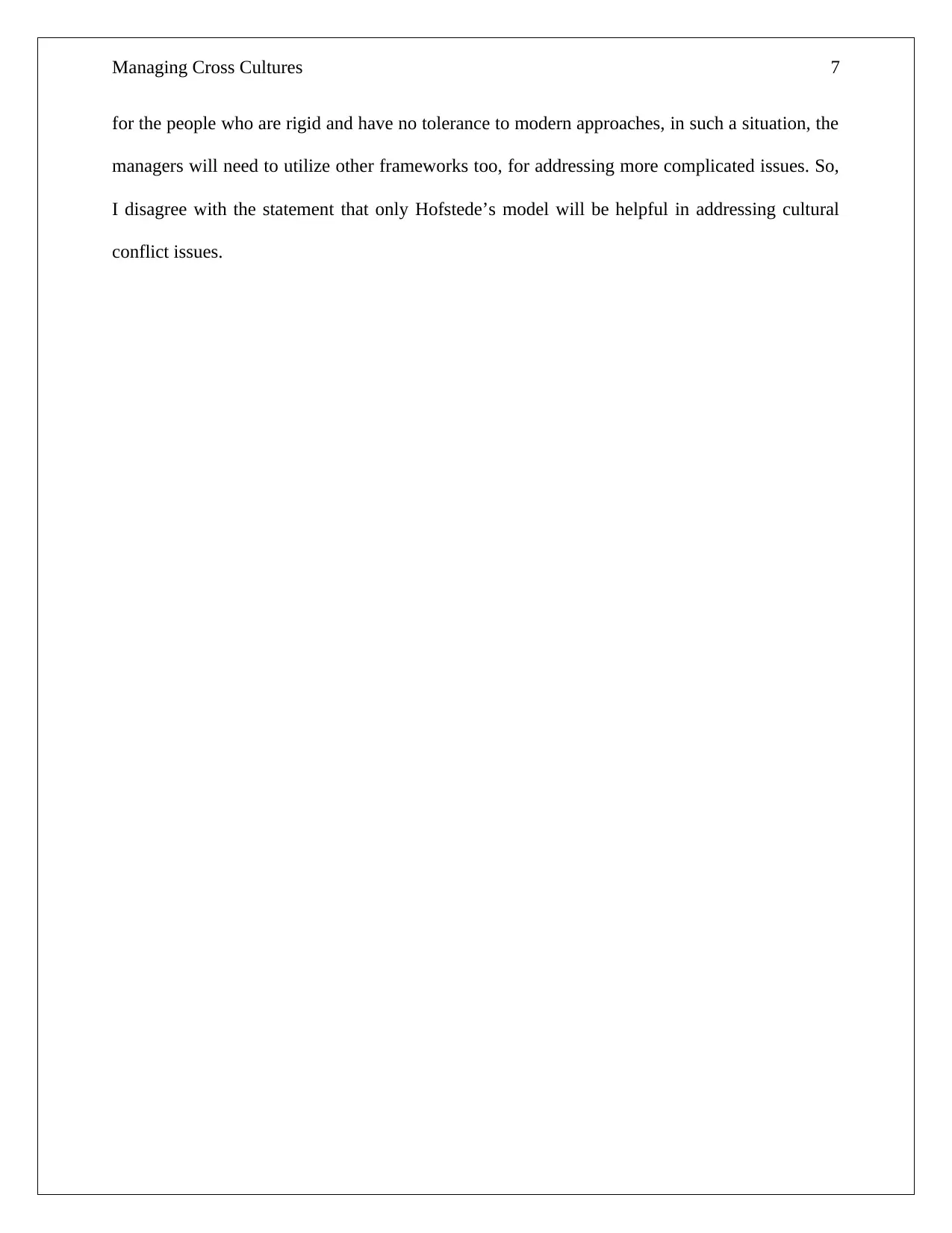
Managing Cross Cultures 7
for the people who are rigid and have no tolerance to modern approaches, in such a situation, the
managers will need to utilize other frameworks too, for addressing more complicated issues. So,
I disagree with the statement that only Hofstede’s model will be helpful in addressing cultural
conflict issues.
for the people who are rigid and have no tolerance to modern approaches, in such a situation, the
managers will need to utilize other frameworks too, for addressing more complicated issues. So,
I disagree with the statement that only Hofstede’s model will be helpful in addressing cultural
conflict issues.
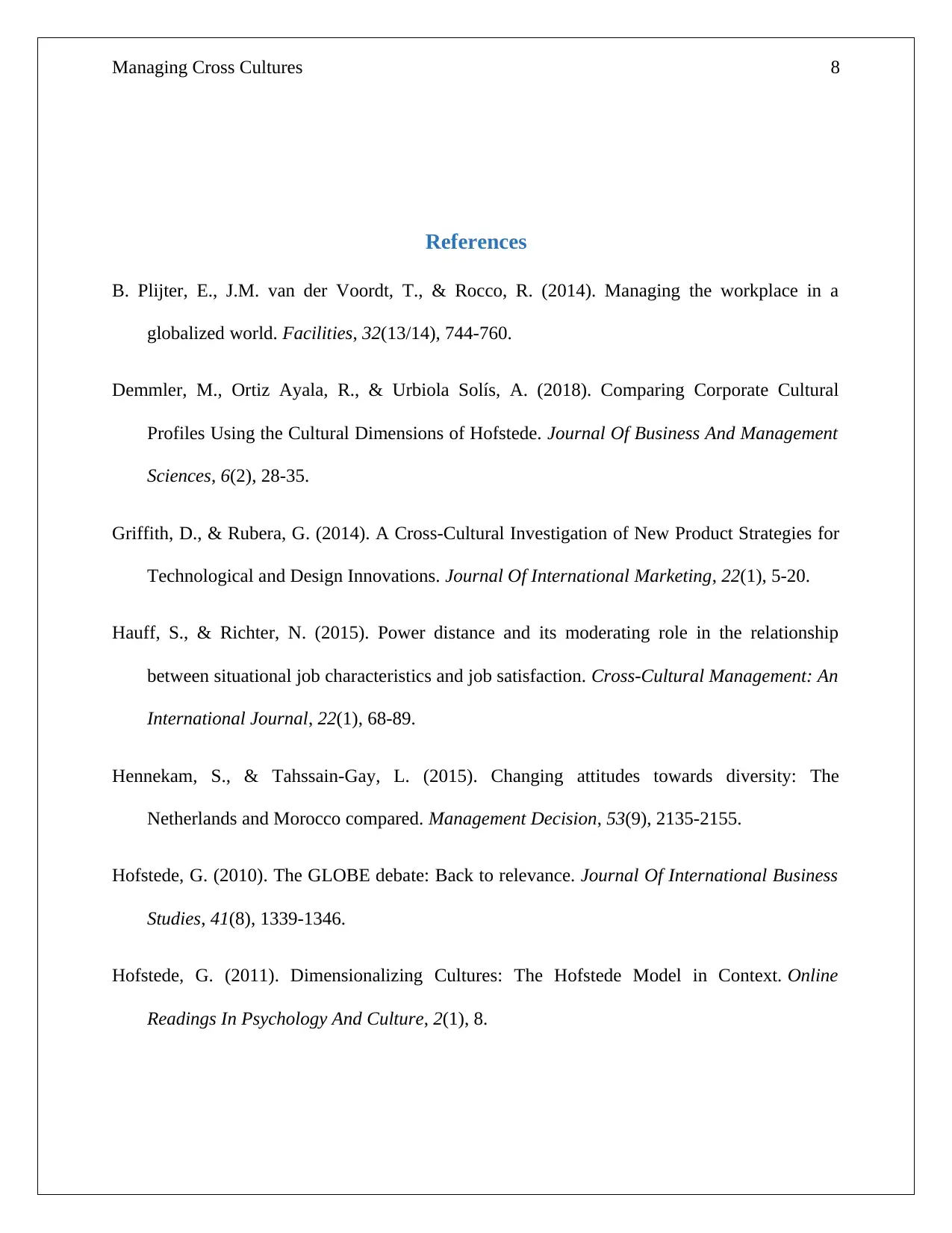
Managing Cross Cultures 8
References
B. Plijter, E., J.M. van der Voordt, T., & Rocco, R. (2014). Managing the workplace in a
globalized world. Facilities, 32(13/14), 744-760.
Demmler, M., Ortiz Ayala, R., & Urbiola Solís, A. (2018). Comparing Corporate Cultural
Profiles Using the Cultural Dimensions of Hofstede. Journal Of Business And Management
Sciences, 6(2), 28-35.
Griffith, D., & Rubera, G. (2014). A Cross-Cultural Investigation of New Product Strategies for
Technological and Design Innovations. Journal Of International Marketing, 22(1), 5-20.
Hauff, S., & Richter, N. (2015). Power distance and its moderating role in the relationship
between situational job characteristics and job satisfaction. Cross-Cultural Management: An
International Journal, 22(1), 68-89.
Hennekam, S., & Tahssain-Gay, L. (2015). Changing attitudes towards diversity: The
Netherlands and Morocco compared. Management Decision, 53(9), 2135-2155.
Hofstede, G. (2010). The GLOBE debate: Back to relevance. Journal Of International Business
Studies, 41(8), 1339-1346.
Hofstede, G. (2011). Dimensionalizing Cultures: The Hofstede Model in Context. Online
Readings In Psychology And Culture, 2(1), 8.
References
B. Plijter, E., J.M. van der Voordt, T., & Rocco, R. (2014). Managing the workplace in a
globalized world. Facilities, 32(13/14), 744-760.
Demmler, M., Ortiz Ayala, R., & Urbiola Solís, A. (2018). Comparing Corporate Cultural
Profiles Using the Cultural Dimensions of Hofstede. Journal Of Business And Management
Sciences, 6(2), 28-35.
Griffith, D., & Rubera, G. (2014). A Cross-Cultural Investigation of New Product Strategies for
Technological and Design Innovations. Journal Of International Marketing, 22(1), 5-20.
Hauff, S., & Richter, N. (2015). Power distance and its moderating role in the relationship
between situational job characteristics and job satisfaction. Cross-Cultural Management: An
International Journal, 22(1), 68-89.
Hennekam, S., & Tahssain-Gay, L. (2015). Changing attitudes towards diversity: The
Netherlands and Morocco compared. Management Decision, 53(9), 2135-2155.
Hofstede, G. (2010). The GLOBE debate: Back to relevance. Journal Of International Business
Studies, 41(8), 1339-1346.
Hofstede, G. (2011). Dimensionalizing Cultures: The Hofstede Model in Context. Online
Readings In Psychology And Culture, 2(1), 8.
⊘ This is a preview!⊘
Do you want full access?
Subscribe today to unlock all pages.

Trusted by 1+ million students worldwide
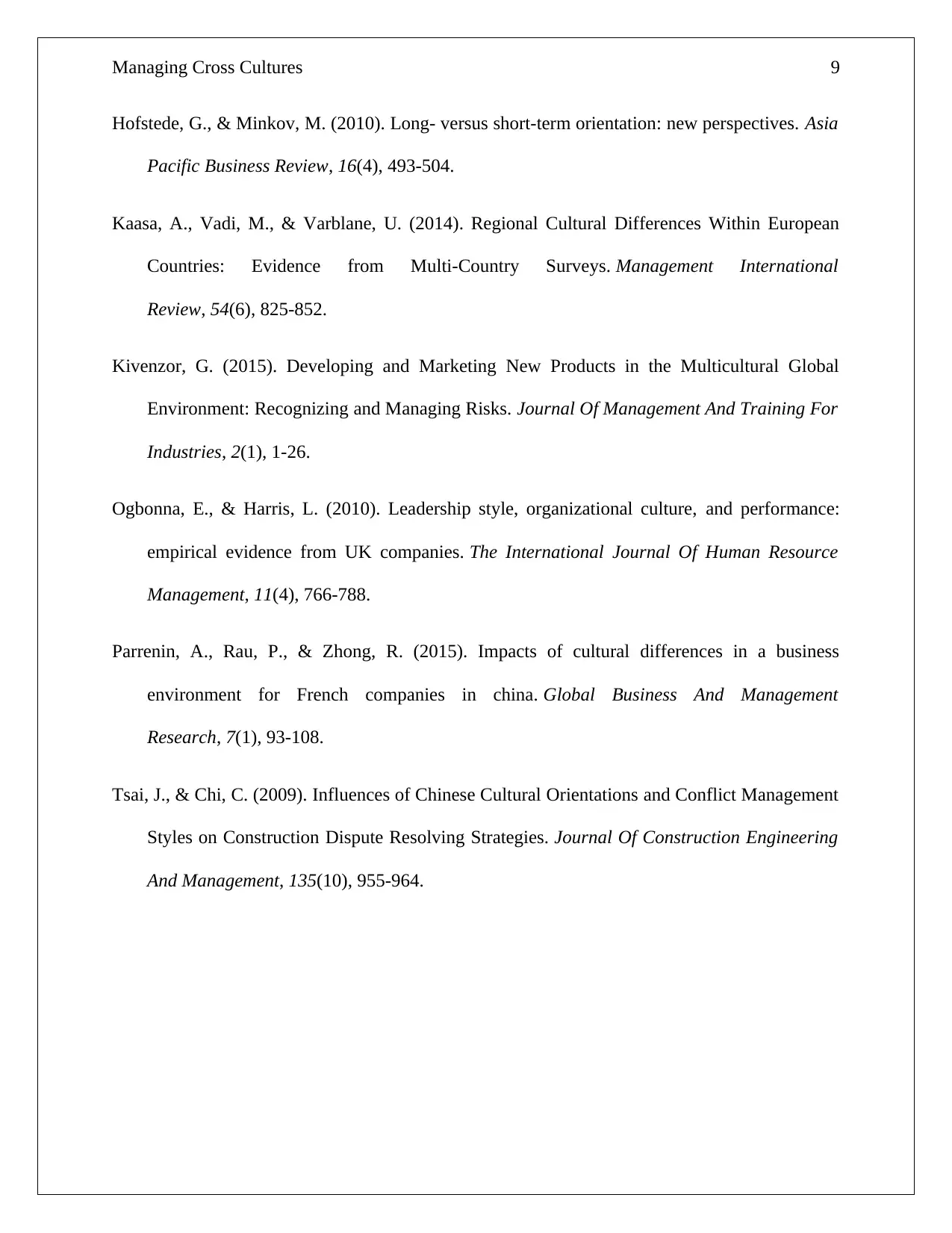
Managing Cross Cultures 9
Hofstede, G., & Minkov, M. (2010). Long- versus short-term orientation: new perspectives. Asia
Pacific Business Review, 16(4), 493-504.
Kaasa, A., Vadi, M., & Varblane, U. (2014). Regional Cultural Differences Within European
Countries: Evidence from Multi-Country Surveys. Management International
Review, 54(6), 825-852.
Kivenzor, G. (2015). Developing and Marketing New Products in the Multicultural Global
Environment: Recognizing and Managing Risks. Journal Of Management And Training For
Industries, 2(1), 1-26.
Ogbonna, E., & Harris, L. (2010). Leadership style, organizational culture, and performance:
empirical evidence from UK companies. The International Journal Of Human Resource
Management, 11(4), 766-788.
Parrenin, A., Rau, P., & Zhong, R. (2015). Impacts of cultural differences in a business
environment for French companies in china. Global Business And Management
Research, 7(1), 93-108.
Tsai, J., & Chi, C. (2009). Influences of Chinese Cultural Orientations and Conflict Management
Styles on Construction Dispute Resolving Strategies. Journal Of Construction Engineering
And Management, 135(10), 955-964.
Hofstede, G., & Minkov, M. (2010). Long- versus short-term orientation: new perspectives. Asia
Pacific Business Review, 16(4), 493-504.
Kaasa, A., Vadi, M., & Varblane, U. (2014). Regional Cultural Differences Within European
Countries: Evidence from Multi-Country Surveys. Management International
Review, 54(6), 825-852.
Kivenzor, G. (2015). Developing and Marketing New Products in the Multicultural Global
Environment: Recognizing and Managing Risks. Journal Of Management And Training For
Industries, 2(1), 1-26.
Ogbonna, E., & Harris, L. (2010). Leadership style, organizational culture, and performance:
empirical evidence from UK companies. The International Journal Of Human Resource
Management, 11(4), 766-788.
Parrenin, A., Rau, P., & Zhong, R. (2015). Impacts of cultural differences in a business
environment for French companies in china. Global Business And Management
Research, 7(1), 93-108.
Tsai, J., & Chi, C. (2009). Influences of Chinese Cultural Orientations and Conflict Management
Styles on Construction Dispute Resolving Strategies. Journal Of Construction Engineering
And Management, 135(10), 955-964.
1 out of 10
Related Documents
Your All-in-One AI-Powered Toolkit for Academic Success.
+13062052269
info@desklib.com
Available 24*7 on WhatsApp / Email
![[object Object]](/_next/static/media/star-bottom.7253800d.svg)
Unlock your academic potential
Copyright © 2020–2025 A2Z Services. All Rights Reserved. Developed and managed by ZUCOL.





